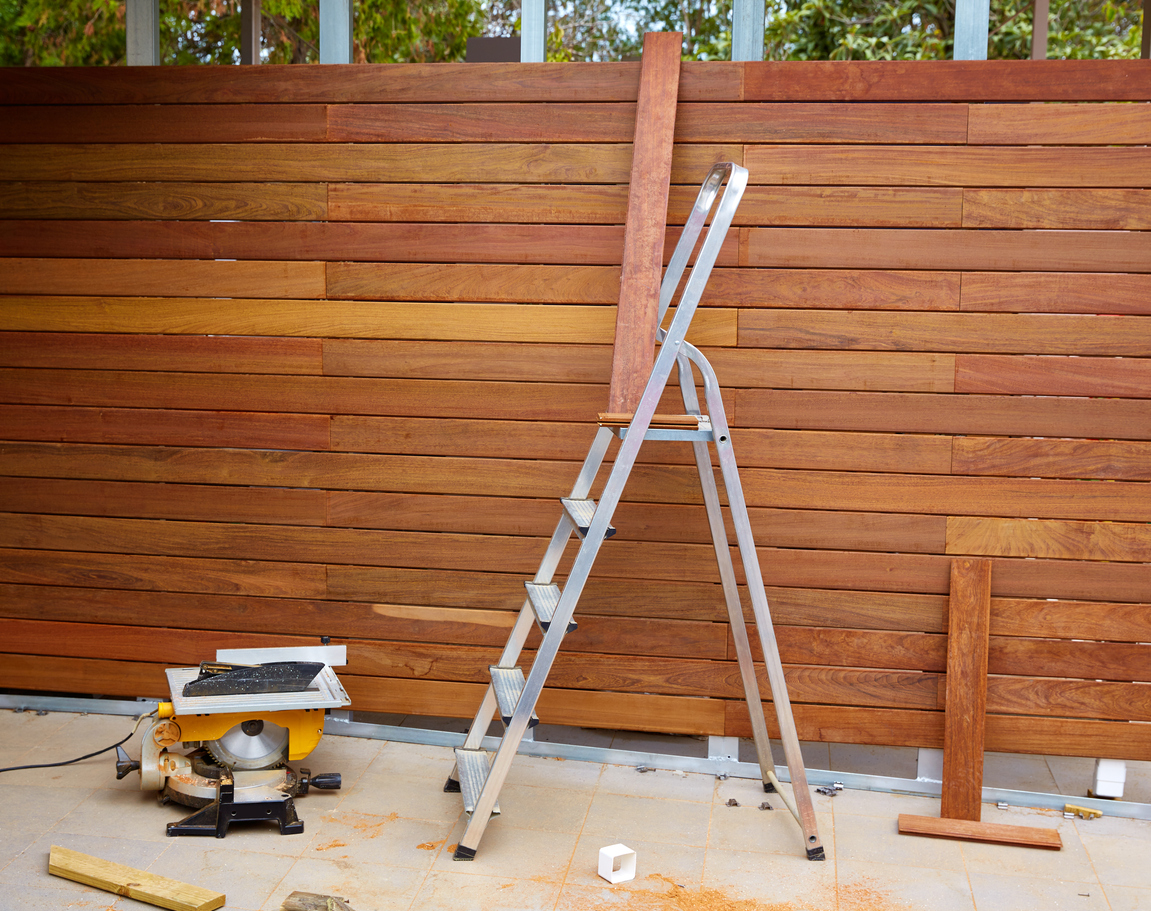We may earn revenue from the products available on this page and participate in affiliate programs. Learn More ›
Highlights
- A wood fence typically costs between $1,763 and $4,416 to install, with homeowners paying a national average of $3,065.
- Among the factors affecting the total cost of a wood fence are the type of wood, the fence size and style, the materials used, the cost of labor and permits, and the home’s geographic location.
- Wood fences offer affordability, durability, privacy, sustainability, easy maintenance, and a potential increase in property value.
- It’s generally recommended that homeowners hire a professional to install a wooden fence properly, since this is a large and complex project.
Wooden fences are popular among homeowners who want to create a private and secure outdoor space or are looking to keep pets and kids contained in their yards—or deer and other critters out. In most cases, wood fencing is chosen over other fencing materials (for example when homeowners are comparing wood vs. vinyl fencing) due to its aesthetic appeal, with many different styles and finishes to choose from.
According to HomeAdvisor and Angi, wood fence cost ranges from $1,763 to $4,416, with the average cost of wood fence around $3,065. The cost of wooden fences can vary widely depending on factors such as the type of wood, the size of the fence, and many others described in this cost guide. This cost guide also includes extensive information on the various types of wood fencing, the benefits of a wood fence, and ways to hire a contractor to install wood fencing.
Factors in Calculating Wood Fence Cost
There’s a lot for homeowners to know about fencing, especially when they are trying to estimate the cost of a new one. The factors that affect wood fence prices are highlighted below to allow homeowners to get an idea of how much this project might cost.
Wood Type
The type of wood used to build a fence plays a significant role in the cost. Generally speaking, the more durable a wood type is, the more a homeowner can expect to pay for it. For example, pine and spruce are relatively soft woods, so they come at a lower price point than redwood and white oak. Additionally, some wood types are rarer than others, making the price higher—black locust, for example, can be hard to come by and is also one of the most expensive types of wood fencing. The cost for each wood type is explained in more detail in a section below.
Fence Style, Height, and Length
Wooden fences come in many different styles, heights, and lengths, with the choice ultimately depending on each property and a homeowner’s personal preferences. Popular fence designs include privacy, picket, and split rail, each described in detail below.
| Fence Style | Cost Per Linear Foot (Including Installation) |
| Privacy | $27 to $60 |
| Picket | $10 to $75 |
| Split rail | $12 to $30 |
- Privacy. A privacy fence essentially means that the fence is tall enough to limit visual and physical access to a yard. Depending on the property, a 4-foot-high fence may offer enough privacy, but most privacy fences are 6 feet high. The cost to install a privacy fence ranges from $7 to $15 per linear foot, or $27 to $60 per linear foot including installation.
- Picket. Picket fences have many vertical boards and are typically 3 or 4 feet high. The cost of a picket fence usually falls in the range of $3 to $30 per linear foot or $10 to $75 per linear foot including installation. This style of fence ranges in complexity, hence the wider price range.
- Split Rail. Split-rail fences have many other names, among them post and beam, slip beam, and post and rail. Essentially, vertical rails attach to horizontal posts, and the rails are split between each post rather than being continuous. Homeowners can expect to pay between $4 and $12 per linear foot or between $12 and $30 per linear foot with installation for a split-rail fence. Split-rail fences are a popular choice for ranches and farms. For a wood ranch fence, split rails are easy to install and maintain in secluded areas.
Materials
There’s a lot more to a fence than just the vertical pickets, so it’s important for a homeowner to consider the cost of all types of fence materials when estimating the price of a new fence. A single 6-foot-tall picket that makes up a wood panel fence can cost anywhere from $1 to $15, depending on the type of wood. For the vertical fence posts (typically 4- by 4-inch pressure-treated wood) that support the pickets, homeowners can expect to pay $10 to $12 each. Caps for those posts cost $5 to $50 each and can be wood, metal, copper, or plastic. The posts are typically mounted in concrete, which costs $0.10 to $0.50 per pound. Last but not least, most fences will need to be painted or stained to improve their longevity and keep out water and insects, adding to the total cost.
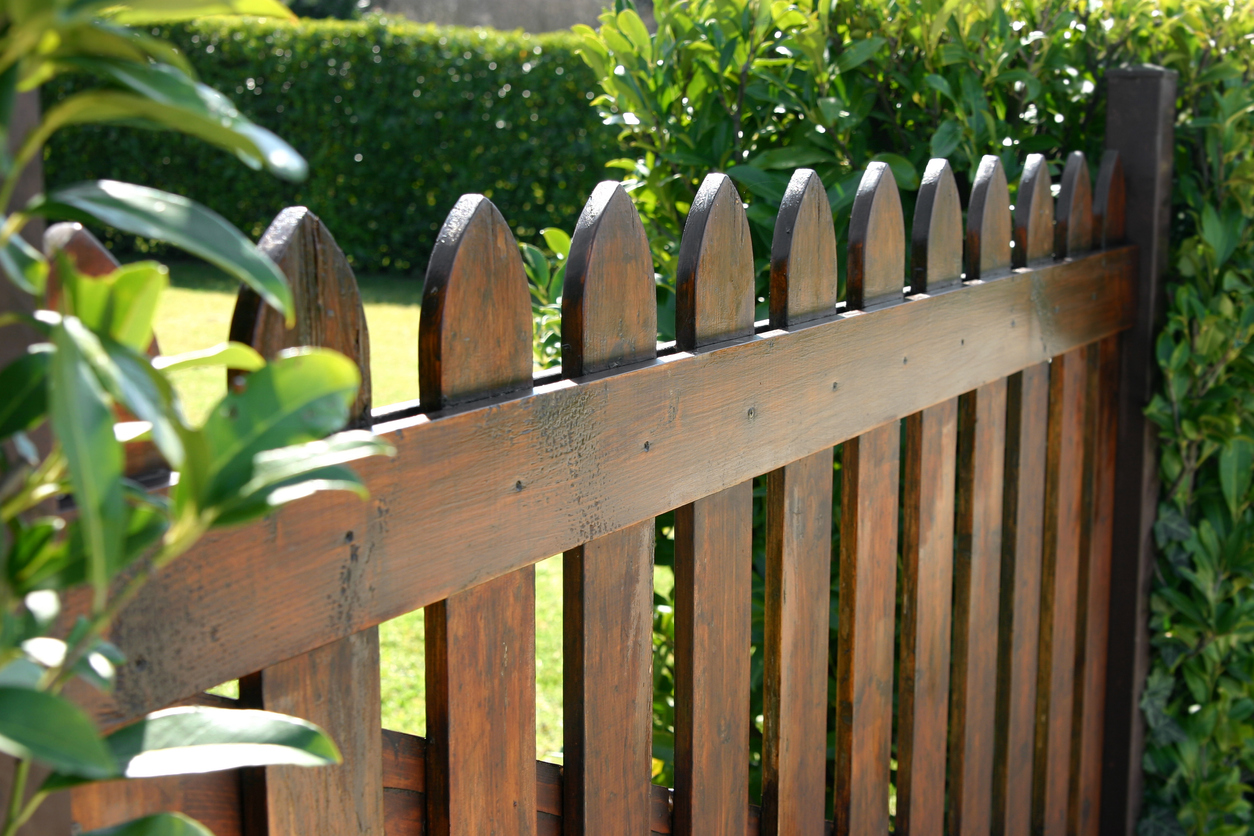
Labor and Permits
Labor will often cost as much as the fencing material itself, if not more. Homeowners can expect to pay $17 to $45 per linear foot for the cost of wood fence installation. The exact cost will depend on the experience of the fencing company the homeowner hires and the difficulty of installing a fence on their particular property. It’s recommended that homeowners get more than just one fence quote to compare prices and choose the best-value option. In addition to paying labor costs, a homeowner may need to pay for a land survey to determine their property boundaries and locations where the fence can be installed to avoid encroachment on neighbors’ property as well as conflict with utility lines. A land survey typically costs $375 to $750. A building permit may also be required and costs $200 to $600.
Geographic Location
The cost of a new fence will certainly vary from location to location. In areas where the cost of living is higher, the price for a wooden fence will likely also be higher. Labor and materials tend to be in greater demand in higher-cost-of-living areas, so more expensive prices are warranted. To avoid paying more in these locations, homeowners are advised to shop around for both materials and contractors to find better deals, keeping in mind that cheaper is not always better.
Additional Costs and Considerations
Before a homeowner seeks out a wood fence cost calculator to determine the cost of a new fence, it is important for them to know every factor that can affect the price. In addition to the factors described above, the following additional costs may apply to some fencing projects.
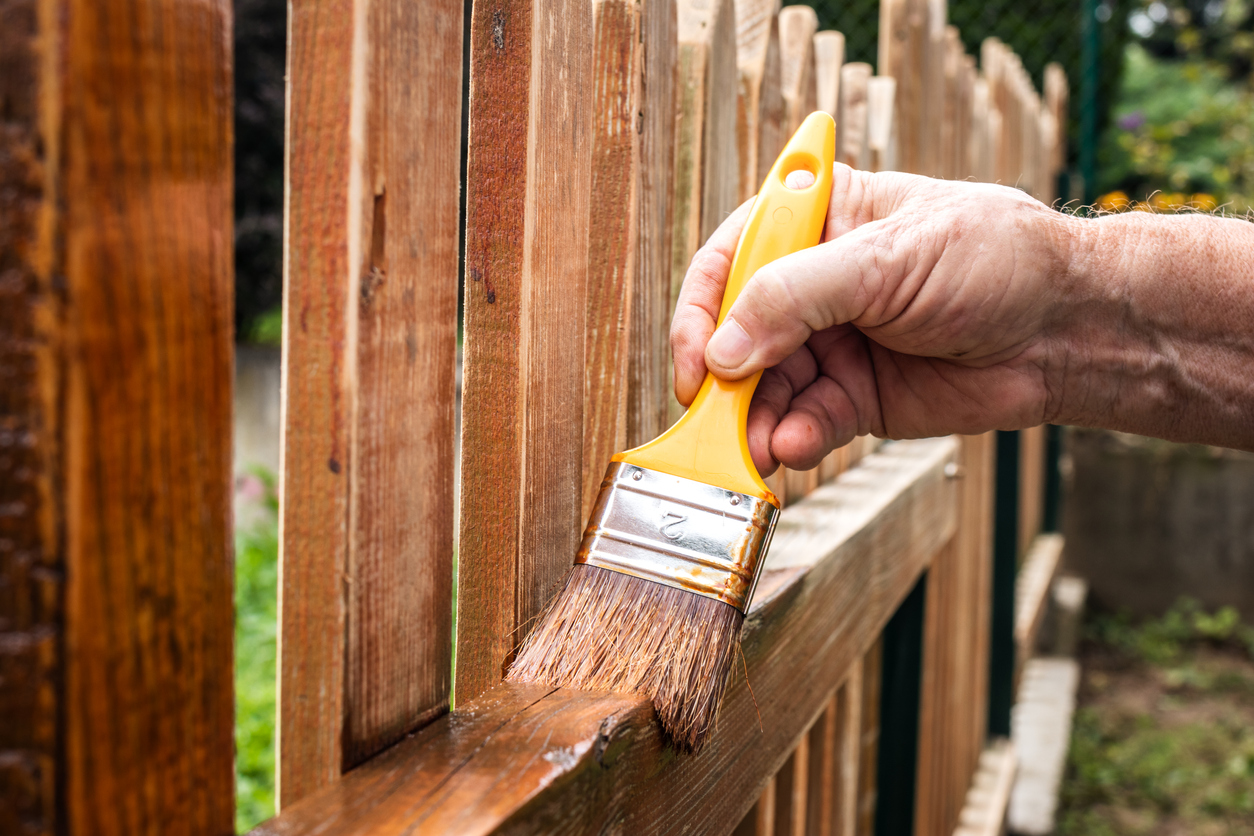
Sealing, Staining, and Painting
Most wooden fences, with the exception of composite fencing, will need to be sealed to lock out water and pests. In addition to the initial sealing, resealing will be necessary every couple of years as the paint or stain wears away. Stain typically costs $1 to $2.25 per square foot; paint is slightly more expensive at $1.50 to $3 per square foot. Since most people choose wooden fencing for its aesthetic value and wood grain, staining is the popular sealant option.
Gate Installation
Most fences require at least one gate as another way to access the backyard beside a patio door or back door. Fence gates typically cost $150 to $600. The gate will usually be made of the same material as the fence, so if that is a more expensive material, a homeowner can expect the gate to be in a similar price range. Gates are relatively easy to install and will have hinges and a closing mechanism; some will also have a lock for security.
Customizations
Wooden fences can add plenty of visual and functional value to a home, and certain customizations can expand that value. Below are a few common customizations a homeowner can add to their new wood fence to improve the result.
| Customization | Cost |
| Waterproofing | $1 to $3 per linear foot |
| Batten board | $3,500 to $4,500 |
| Lattice tops | $2 to $20 each |
- Waterproofing. Fences can be waterproofed for just $1 to $3 per linear foot. A waterproofing sealant helps to ensure water does not soak into the wood, but it does need to be reapplied every couple of years. Homeowners looking to put a fence up around their pool may want to steer clear of wooden fencing. While the cost of pool fencing made from metal or glass may be more expensive than the cost of wood, wood is not a good choice in the water-ridden environment surrounding a pool.
- Batten Board. To add a significant aesthetic feature to a home, some homeowners choose to place batten boards on one side of the fencing. Doing so increases the visual interest of a wooden fence. The upgrade typically costs $3,500 and $4,500 total.
- Lattice Tops. Lattice, a structure made of interlacing strips of wood used as a support for climbing plants, can be affixed to the top of a wooden fence. For $2 to $20 per top, homeowners can give their plants a place to spread their vines above the new fence.
Old Fence Removal
For those wanting to replace an old fence, wood fence replacement cost will often include the cost of removing the existing one. In most cases, removing an old fence will cost between $2 and $5 per linear foot, but it does depend on the condition and location of the fence. While repairing an older fence, like fixing a leaning fence, is possible, if the wood has experienced years of water damage or insect infestation, it is best to remove it and replace the fence altogether.
Grading or Resloping
Fences are easier to install on flat, even land. While it is possible to install fences on sloped surfaces, the area may need to be reworked and graded before the new fencing goes in. Only backyards with hilly or rough terrain will require grading or resloping. Homeowners can expect to pay from $19 to $43 per square foot for grading. If any trees need to be removed, tree removal costs range from $200 to $1,000 or more per tree.
Wood Fence Cost by Type of Wood
When homeowners are choosing a type of wood for fencing, options are endless. Below is a list with details about the most common types of wood used for residential fencing, along with the cost to install a fence per foot depending on the type of wood selected.
| Wood Type | Cost Per Linear Foot (Including Installation) |
| Bamboo | $10 to $15 |
| Black locust | $20 to $40 |
| Cedar | $5 to $15 |
| Composite | $15 to $35 |
| Cypress | $10 to $15 |
| Douglas fir | $15 to $20 |
| Ipe | $5 to $20 |
| Pine | $3 to $10 |
| Redwood | $15 to $30 |
| Spruce | $3 to $10 |
| Tropical hardwood | $20 to $30 |
| Western red cedar | $5 to $15 |
| White oak | $15 to $40 |
Bamboo
Homeowners can expect to pay $10 to $15 per linear foot for bamboo fencing materials or $20 to $30 per linear foot for a complete installation. Bamboo fences can be either light or dark in color and are typically used in more tropical areas. Installing a fence made with bamboo is one of the most sustainable wood fence options; bamboo grows back very quickly after being planted, unlike other wood used for fencing.
Black Locust
For $20 to $40 per linear foot or $30 to $60 per linear foot installed, black locust is one of the most expensive fencing types. The material is very durable and long-lasting; however, it is not as readily available as other woods, leading to the costly price tag. Black locust fencing requires little maintenance, so it is a good option for properties that may not be attended to often.
Cedar
Cedar wood fencing typically costs between $5 and $15 per linear foot for materials or between $15 and $30 per linear foot including installation. Cedar has a slight reddish tone that may not appeal to every homeowner, but it can certainly warm up the exterior of a home. This type of wood requires less maintenance than others, as it is a bit denser and weather-resistant. It is best in dry climates with little to no humidity.
Composite
Composite wood fencing is not entirely wood. For $15 to $35 per linear foot for materials and $25 to $55 per linear foot for materials and installation, composite wood fencing combines the look of natural wood with the durability of plastic. This engineered material will outlast most wood alternatives, standing up to the weather, water, and pests. Some may say it lacks the character of real wood, but that is a small price to pay for the remarkably durable material.
Cypress
Cypress is a bit more costly than other wood fencing choices. Homeowners can expect to pay $10 to $15 per linear foot for materials and $20 to $30 per linear foot including installation. The dense wood has a beautiful look that many favor, leading to a slightly higher price. Cypress contains cypretine, a natural chemical that blocks insects. It is also weather-resistant and will dispel water if properly protected with a sealant.
Douglas Fir
Douglas fir is often chosen for Christmas trees but makes a suitable fencing material as well. For Douglas fir fencing, most will pay $15 to $20 per linear foot for materials and $25 to $40 per linear foot for materials and installation. Douglas fir is considered a softwood but is much stronger than other softwoods like pine. It can be treated and sealed to extend its lifespan and prevent it from graying over time.
Ipe
Ipe is a lesser-known material used for wooden fencing. It costs $5 to $20 per linear foot for materials and $15 to $35 per linear foot for materials and installation. Ipe is a tropical hardwood and is sometimes called Brazilian walnut due to its origins and deep brown color. The wood is very dense, making it difficult for water or insects to penetrate the surface. With proper maintenance and regular staining, ipe wood fencing will last many years.
Pine
Pine is a relatively inexpensive wood fencing option at $3 to $10 per linear foot for materials and $10 to $25 per linear foot for materials and installation. While pine is used more often for interior trim, it is suitable for exterior fencing. Treated pine wood will last for many years outside, but it can warp over time if not maintained and protected.
Redwood
As the name suggests, redwood fencing takes on a rich red tone. For $15 to $30 per linear foot or $25 to $40 per linear foot installed, redwood is a premium wood fencing material. It will stand up to insects, weather, and UV rays so long as it is treated. Redwood is suitable in warm, humid climates.
Spruce
Homeowners can expect to pay between $3 and $10 per linear foot for spruce wood fencing. Fully installed, this type of fencing will cost closer to $10 to $25 per linear foot. Spruce is a good fencing option for those on a budget. Because it is not as durable as other woods and can warp over time, the material is a bit lower quality and therefore less expensive than others. To protect the surface and keep it from graying, homeowners are advised to apply a protective stain coating and restain every few years.
Tropical Hardwood
Tropical hardwood fencing costs $20 to $30 per linear foot for materials and $30 to $50 per linear foot for materials and installation. This type of fencing tends to have a more exotic look, making it the perfect choice for a vacation home or beachside bungalow. Common tropical hardwoods used for fencing include batu, tigerwood, and cumaru. Each will have a warm color and last many years, but they do come at a higher price.
Western Red Cedar
Western red cedar is another relatively inexpensive wood fencing material and costs between $5 and $15 per linear foot. The cost including labor rises to $15 to $30 per linear foot. Western red cedar has a warmer, more reddish tone than traditional cedar, and that is the reason homeowners may choose this version over the other. Like cedar, western red cedar is fairly weather-resistant and less likely to warp than other types of wood.
White Oak
The cost of wood fences made from white oak ranges from $15 to $40 per linear foot for materials and $25 to $60 per linear foot for materials and installation. It is a highly sought-after material for furniture, flooring, and fencing, hence the premium price point. White oak not only looks beautiful with its lighter finish but will also hold its own in extreme weather. While it can warp in humid environments, it tends to resist rotting when properly sealed.
Benefits of Installing a Wood Fence
Installing a wood fence has many benefits beyond just creating a secure backyard. Below are the top benefits that homeowners will see if they choose to install a wood fence on their property.
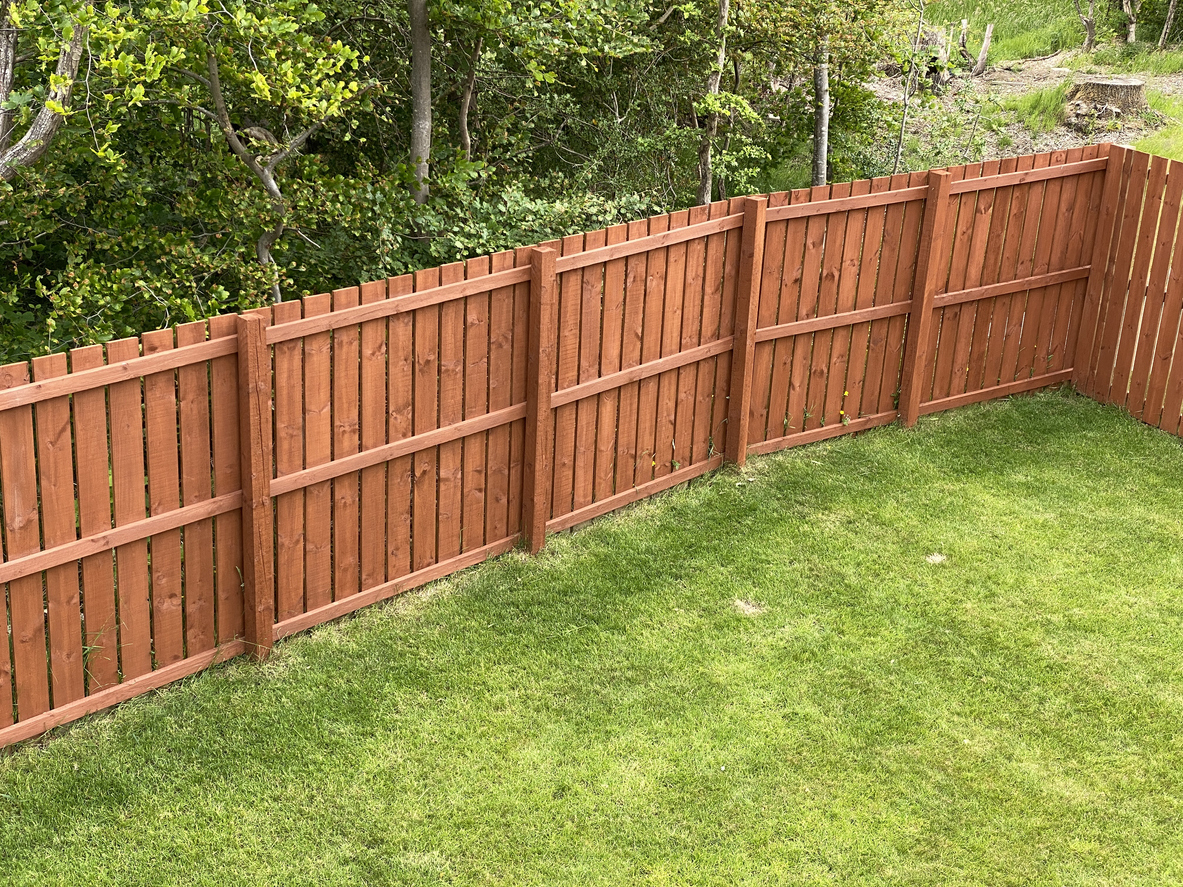
Affordability
When it comes to the cost of various fencing materials, wood, specifically pine, tends to be the most affordable. The cost of pine wood fencing is usually cheaper than the cost of chain link fencing or the cost of vinyl fencing. This is not always the case if a homeowner chooses a more expensive type of wood, like oak or redwood, but pine, cedar, and spruce are typically more affordable materials.
Easy Maintenance
Wood fences are very easy to maintain. They can be cleaned with simple soap and water rather than expensive chemicals, and replacing any damaged parts will be simpler than replacing an entire fence panel. Wooden fencing needs to be repainted or restained every few years; however, this can be a fairly simple DIY project.
Durability
Installing wood fencing is a very durable option, often more so than installing vinyl fencing. The durability does depend on the type of wood a homeowner chooses, but for the most part, all wooden fences will hold up for many years, even many decades. Proper maintenance and care are important aspects of keeping a wood fence long-lasting.
Sustainability
Since wood is a renewable resource, wood fences are a sustainable choice for fencing material, as trees can be replanted to replace the fallen trees that made the fencing material. Bamboo is a particularly sustainable fencing choice, as it will grow back very fast. At the end of a fence’s life, the wood can be recycled and repurposed, which is not always the case with a vinyl or chain link fence.
Privacy
Many homeowners opt to install a fence simply for privacy. A wood privacy fence will help keep a backyard safe and secluded from neighbors. Additionally, it can keep pets from being distracted by animals or people at other properties. There are many different styles of privacy fences, and some are taller than others to maximize privacy.
Increased Property Value
While it is not always the case, adding a fence can increase a property’s value. The initial cost, or at least a portion of it, may be recouped upon the sale of the home, especially if having a fence is important to the new buyers. Buyers with children or pets tend to seek out homes with fences, so adding one could make a home more attractive to future buyers.
Wood Fence Installation: DIY vs. Hiring a Professional
Some homeowners might set out to install their own wooden fencing, but DIY fence installation is not for the faint of heart. It requires a lot of knowledge about the process as well as hard physical labor. Digging the post holes, installing and leveling the posts, and setting the posts in concrete are difficult tasks, and those are just a few of the many steps required during a new fence installation. Unless a homeowner has just a few feet of fence to install, this is a project best left to the pros.
The best fence companies will walk a homeowner through each step of the process, from planning to execution, ensuring they understand everything that is required. They will be able to request a land survey and file for a building permit as needed. A homeowner can rely on a fence professional’s expertise to recommend certain materials and the layout for a fence.
When it comes to actually building the fence, the experienced installer will ensure everything is plumb, level, and sturdy. Homeowners will want to consider also hiring a professional to seal their new wooden fencing. Fresh and even paint or stain ensures the fence is protected and looks beautiful too.
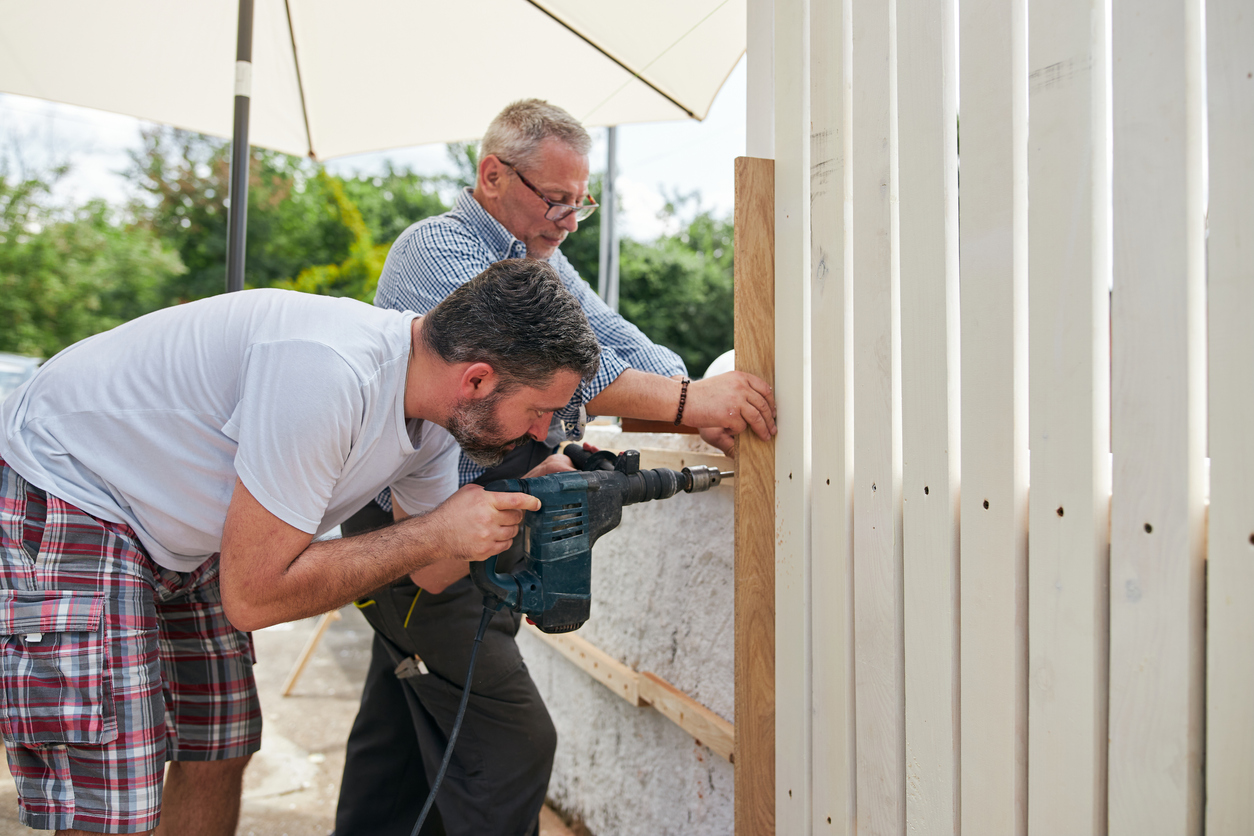
How to Save Money on Wood Fence Cost
Installing a new wood fence can be a costly undertaking. In addition to using a wood fence calculator to determine fence installation costs, homeowners can use the following money-saving tips to help cut down on the cost and keep some more money in their pocket.
- Choose a cheaper type of wood. To save money on a new fence, picking the most affordable type of wood is the best place to start. Pine and spruce are the cheapest wood fencing materials, and choosing one or the other does not compromise the quality of your new wood fence, as each one is quite durable.
- Skip the add-ons. When building a new wooden fence, you will have the option to add decorative features, such as post caps or lattice, that are simply not necessary. Skip these add-ons to save a couple of bucks.
- Shop around. Seek out all of your options as far as fencing materials and fencing installers. Request pricing from multiple sources so you can choose the most affordable yet quality options.
Questions to Ask About Wood Fence Installation
Before hiring a professional to install a new wooden fence, homeowners will benefit from fully vetting the company and ensuring they are hiring someone capable of performing the job. Homeowners can use the questions listed below to compare the quality of service with each company and ultimately choose the best one to work with.
- Do you offer free estimates?
- Will you provide a written quote and contract?
- Are you licensed and insured to complete this type of work?
- How long have you been in business?
- What kind of training do you offer for your employees?
- Will the work be completed by an employee of your business or by a subcontractor?
- Can you provide references from similar projects?
- What type of wood do you recommend?
- Are you able to seal, stain, or paint the fence?
- Will my property require any resloping or grading to install the fence?
- Will you contact utility companies to ensure there are no conflicts with the new fencing?
- How long will the fencing installation project take?
- Do you require a down payment, and if so, how much?
- What is the payment schedule, and do you offer payment plans?
- Do you offer a warranty on your work?
- How soon can you schedule the work?
- How can I get in touch with you while the project is in progress?
- Do you take care of cleanup after the project is complete?
- How will you protect my home from damage during the project?
- How do you handle disputes or disagreements?
- Will this project require a land survey or building permit?
FAQs
Before starting a fence-building project, a homeowner will want to make sure they are completely informed about the process and set reasonable expectations. The following frequently asked questions can help homeowners better prepare for the construction of their new wood fence.
Q. What is the average cost of a wood fence?
The average cost of a wood fence is about $3,000. The price will vary depending on the type of wood a homeowner chooses, the size of the fence, the fence style, and many other factors. Before starting a new fence installation project, homeowners are advised to research the cost of all the different types and reach out to multiple contractors to request pricing quotes.
Q. What is the easiest fence to install by yourself?
The easiest fence to install by yourself is a wooden post and rail fence. A post and rail fence has evenly spaced vertical posts with cutouts for rails to slide through. After the posts and rails are cut to size, it is as simple as digging holes for the posts and installing the rails. Homeowners will want to keep in mind, however, that a post and rail fence may not provide the security or privacy that they desire.
Q. How long does it take to install a wood fence?
It usually takes between 1 and 4 days to install a wood fence, but the duration ultimately depends on the size of the project, the complexity of the fencing, and the experience of the installers. It will take a DIYer much longer to install a fence than a trained fence installation company. Certain types of wood fencing are more time-consuming to install, as the wood is heavier and more difficult to prop up.
Q. How long does a wood fence last on average?
A maintained wood fence will last around 15 years but can last over 20 years in some cases. How well the fence is taken care of over the years really impacts its longevity. Wood fences must be resealed every couple of years to protect them from the rain and wind. Wooden fencing in dry climates tends to last longer than in moist or humid climates.
Q. What is the best type of wood for a wood fence?
The best type of wood for a wood fence is cedar. It is fairly inexpensive and has impressive features such as long-lasting durability and a beautiful look. The wood is also naturally resistant to pests and insects. Additionally, it is not as likely to warp over time when compared to other woods like pine and spruce.
Sources: Angi, HomeAdvisor, Fixr, Bravo Fence

